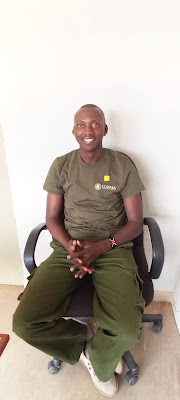Ambrosia
Ambrose
In many ways, Ambrose has already achieved stardom and he has a reputation for getting on and getting things done. He has appeared on television with wildlife film maker, Paula Kahumbu, in a programme called Wildlife Warriors and he was the person who captured pictures of the black leopard for San Diego Zoo. At the moment he is studying for his degree in Environmental Science Conservation with the University of Africa Nazarene and has high hopes of travelling to either the United Kingdom or the United States to complete a Master’s Degree in a related subject as soon as he has finished. However, the coronavirus pandemic has seriously interfered with the way many degree courses have been run in Kenya and yet at no stage, even with enormous technological problems, has Ambrose let this stand in his way. Instead, he is studying from home, with intermittent access to the internet, and taking life-lessons in resilience and fortitude.
In fact, Ambrose’s whole life has never been easy and he believes that it his determination, the help of friends, and the help of God that has got him this far.
Ambrose was born in the small village of Poro in Samburu County and is the son of pastoralists. Neither his mother nor his father were given the opportunity to go to school, and his mother was forced into marriage at a very young age. Before this she was also subjected to the now illegal practice of female genital mutilation (FGM) after which she came close to losing her life. Once married, she was subjected to domestic abuse and it was seeing and hearing about these events that shaped Ambrose’s mind-set. His mother vowed that Ambrose would be educated, and Ambrose vowed that he would fight for women’s rights alongside his pursuit of a career in conservation.
Ambrose’s mother arranged for him to live with his uncle William Mois, and it was under his guardianship that Ambrose attended Ewaso Primary School. Later, thanks to his uncle’s generosity, he was also able to attend high school.
“When my uncle sadly died, I realised that I wouldn’t be able to pay the fees to continue with my schooling. I was desperate to become a conservationist, and decided to write a letter to Lori DeNooyer, who works closely with Loisaba in providing scholarships and educational support to surrounding communities. Loisaba made an amazing difference to our school, funding replacement classrooms, a new kitchen and dormitories, and providing solar power. Lori had attended my school on several occasions to open the new facilities. She didn’t really know me individually, but luckily she read my letter and decided to help me. She introduced me to an American gentleman called William Byron who was prepared to sponsor me for the rest of my high school and college education.”
Ambrose recalls thinking about the power of prayer and in particular, Jeremiah 29:11 which says, “I have plans for you, not plans for destruction but plans for your prosperity.”
He worked hard to reward those who believed in him and obtained an internship at Loisaba Conservancy which eventually led to further research work on behalf of San Diego Zoo Wildlife Alliance. Ambrose’s focus was on the leopards in Loisaba and the potential conflict with the livestock herders in the local community. Using camera trap footage, entailing hours of work setting up and monitoring the cameras, Ambrose was able to form a picture of the leopard population around Loisaba, estimated to be at least forty individuals. Further footage, taken in community bomas, proved that leopards were responsible for only 2% of the losses of community stock animals. This information represented a real breakthrough and resulted in a change of attitude towards the beleaguered leopards, who had been at considerable risk of being killed if seen by members of the community.
Ambrose’s degree continues and it won’t be long before he can announce the results of his current research into leopards. However, he has also taken advantage of his time spent at home setting up a Wildlife Resource Centre for local children which has attracted the attention of many organisations around the world that are now offering to help with further resources.
“I believe that every creature that God created has a purpose and a right to life, and with the participation of local people we can avoid the extinction of these creatures,” says Ambrose.
Beyond this, he has also given a lot of support to the women in his local community knows as the Chui Mamas (Leopard Mamas) who not only make and sell their own beadwork but have been producing re-useable sanitary pads for women and girls, as well as essential face masks during the pandemic. He does not shy away from issues such as FGM and continues to campaign for an alternative rite of passage for young women.
Still in his twenties, Ambrose has gained the respect of many of his elders, peers, and fellow conservationists, and manages to tread a fine line between cultural tradition and modern values. Although he may travel the world in the future, his heart will always be with the Samburu, and his pastoralist heritage. Laikipia will always be his home.








Comments
Post a Comment